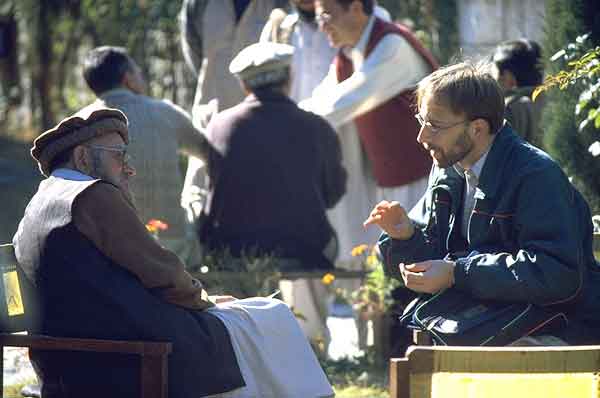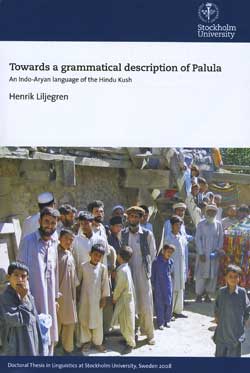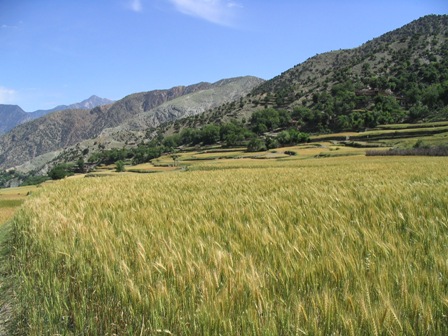SWEDISH SOUTH ASIAN STUDIES NETWORK
Department of Linguistics, Stockholm University:
Postal address: Institutionen för
lingvistik, Stockholms universitet, SE-106 91 Stockholm, Sweden
Visiting address: Universitetsvägen 10 C, Frescati,
House C, 1st and 2nd floors
Web page: http://www.ling.su.se/
Contact person: Dr. Henrik Liljegren, phone: +46 (0)8-16 2722
South Asia related research at the department:

Henrik Liljegren, defended his doctoral dissertation titled ”Towards a grammatical description of Palula, an Indo-Aryan
language of the Hindu Kush” on Monday 2 June 2008.
The dissertation is intended to provide a grammatical description of the Indo-
Aryan language Palula, spoken by approximately 10,000 people in Chitral
District in Pakistan’s North-West Frontier Province. Faculty opponent was Professor Peter E. Hook, University of Virginia, United States. More information. ![]()
(Henrik on the photo to the right along with one of his key informants
in village Biori, where Palula is widely spoken)
Abstract of the project: No study with the scope
and detail of the current work has been presented in the past for this little-known language, and it is one of only a few in-depth studies available for
languages in the immediate surrounding of the Hindu Kush region.
 Palula is spoken by approximately 8,000–10,000
individuals in the two side-valleys Ashret and Biori in Chitral
district, just on the border
to Afghanistan. The speech variety is clearly distinct from its nearest
linguistic relative in the Indus Valley, Kohistani Shina. The Indus Valley
is also the probable origin of today’s Palula speakers, from where
they according to local historical records migrated some 14-15 generations
ago.
Palula is spoken by approximately 8,000–10,000
individuals in the two side-valleys Ashret and Biori in Chitral
district, just on the border
to Afghanistan. The speech variety is clearly distinct from its nearest
linguistic relative in the Indus Valley, Kohistani Shina. The Indus Valley
is also the probable origin of today’s Palula speakers, from where
they according to local historical records migrated some 14-15 generations
ago.
The analysis is based on original data primarily collected during the period
1998-2006, mainly in the form of recorded texts but supplemented by
questionnaires, notes of observed language use and the elicitation of word
lists and paradigms. The field work has been conducted in close cooperation
with native speakers and their communities.
The description covers phonology, morphology, syntax and a range of the most
important topics within each of these sub-disciplines, but it is not meant to
be an exhaustive reference grammar. Some topics have been given greater
prominence in the work, as they have particular importance to the language,
whereas others have been covered more summarily. Suggestions for further
research that should be undertaken are given throughout the study.
The approach chosen is theory-informed rather than theory-driven, but an
underlying framework of linguistic typology and non-formalism is assumed.
Diachronical development is taken into account, particularly in the area of
morphology, and comparisons with other languages and references to areal
phenomena are included insofar as they were motivated and available.
 During the long period of fieldwork in Pakistan, Henrik Liljegren has been connected to the Frontier
Language Institute (FLI), a non-sectarian, nonprofit training institution
and resource centre based in Peshawar. Henrik took part in the establishment
of the institute in 2003. It conducts research on languages spoken in different parts of the Frontier. Among 69 languages in Pakistan, 26 are spoken in NWFP and 12 are being used in district Chitral alone.
During the long period of fieldwork in Pakistan, Henrik Liljegren has been connected to the Frontier
Language Institute (FLI), a non-sectarian, nonprofit training institution
and resource centre based in Peshawar. Henrik took part in the establishment
of the institute in 2003. It conducts research on languages spoken in different parts of the Frontier. Among 69 languages in Pakistan, 26 are spoken in NWFP and 12 are being used in district Chitral alone.
The goal for FLI is to train Pakistani individuals in the subjects of
linguistics, literacy, anthropology, lexicography, translation and language
planning in order to empower them to: • Preserve oral traditions,
poetry, proverbs, folk tales and other aspects of their cultural heritage;
• Make bilingual or trilingual dictionaries and glossaries; •
Improve reading and writing skills; and • Produce literature in
the national, regional and vernacular languages of Pakistan.
On Friday 30 May 2008, a symposium on ”South Asian Languages in an Areal-Typological Perspective” was held at the department. It was organised by Henrik Liljegren. Along with Naseem Haider from the Frontier Language Institute in Peshawar, he gave a presentation on ”Some approaches to building lexical databases in languages of the Hindu Kush”. Other participants at the symposium included Prof. Peter E. Hook from the University of Virginia, USA, who talked about ”EAT-expressions in Hindi, Marathi, and Kashmiri”; Dr. Joan Baart from the Summer Institute of Linguistics, who talked about ”Stress and Tone in North-West Indo-Aryan”; Dr. Ruth Schmidt, University of Oslo, who talked about ”Cross-dialect variation in the Shina vocabulary as an effect of language contact”; and Dr. Anju Saxena, Dept. of Linguistics, Uppsala University, who talked about ”Linguistic and cultural (co)variation in Kinnauri – The case of Harijan boli and Kinnauri”.
Henrik Liljegren returned to Pakistan in August 2008 to serve a two-year term as a Language Development and Research Consultant with the Frontier Language Institute.
Currently FLI provides in-service training and other support to three community-based education programmes recently started up in three particular target areas, among them one mother-tongue elementary programme in Palula.
Apart from
this project, Henrik Liljegren cooperates closely with Anjuman-e-taraqqi-e-Palula (the Society for the Promotion of Palula) to help produce a small body of Palula literature and work on a Palula dictionary.
SASNET - Swedish South Asian Studies Network/Lund
University
Address: Scheelevägen 15 D, SE-223 70 Lund, Sweden
Phone: +46 46 222 73 40
Webmaster: Lars Eklund
Last updated
2011-08-15
